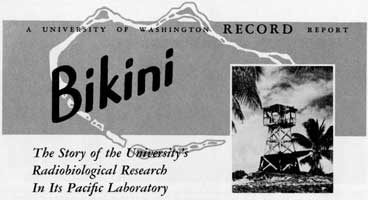History of the Applied Fisheries Laboratory
History of the Applied Fisheries Laboratory
Proving Ground (Book Excerpts)
Chapter 2
Chapter 3
Sample Searches
- 1946 Operation Crossroads
- 1947 Bikini Atoll Radiological Survey
- 1949 Radiological Survey of Bikini, Eniwetok and Likiep Atolls
- 1964 Radiological Survey of Bikini, Eniwetok and Rongelap Atolls
Finding Aids
Guide to the Lauren R. Donaldson Papers 1906-1994
Guide to the University of Washington, Laboratory of Radiation Ecology Records 1944-1984
In August 1943, the Board of Regents, acting on a request from the Office of Scientific Research and Development, created the Applied Fisheries Laboratory at the University of Washington and named Dr. Lauren R. Donaldson as its first director. It was charged with developing methods for evaluating the hazards of radiation in and around water which might be produced by atomic energy plants using water as a cooling agent. Much of the effort of the Laboratory was directed toward evaluation of the effect of the operations at the Hanford Nuclear Site on the Columbia River.
The federal sponsorship changed from the Office of Scientific Research and Development to the Manhattan Engineering District of the Army in 1944 and remained with MED until the passage of the Atomic Energy Act in 1946 at which time the entire program was transferred to the Atomic Energy Commission. In 1946 the lab began studying the biological effects of nuclear weapons tested at the Eniwetok Test Site at Bikini and Eniwetok Atolls in the Marshall Islands. The program at the test site occupied the major effort of the laboratory over the next 12 years. It studied the biological effects of the weapons tested, fallout measurements, drift of radioactive materials in the sea, decay and decline of radiation in the physical and biological environments of the atolls, movement of trace minerals in soil, plants, and animals, and food contamination. After a 1954 incident when a weapon detonated at Bikini Atoll contaminated a Japanese fishing vessel and the Rongelap Atoll in the Eastern Marshall Islands, the Laboratory undertook studies of oceanic contamination of fishes which included joint studies with the Japanese of the tuna fish of the western pacific and a study of the possible contamination of native foods at Rongelap. These studies expanded to include detailed investigations of the ecology of Rongelap, using residual traces of radiation as an aid to following trace minerals in the life of the atoll. A continual effort was made to translate the basic concepts that evolved from the radiobiological studies at the Eniwetok Test Site to the fields of marine ecology, oceanography, trace mineral metabolism, physiology of coral formation, crustacean physiology, and fish migration.
In 1957, the contract with the Atomic Energy Commission expanded to develop a cooperative laboratory with the Washington Department of Game at Fern Lake in Kitsap County, Washington. The name of the Applied Fisheries Laboratory changed in 1958 to Laboratory of Radiation Biology, and in 1966 that name changed to Laboratory of Radiation Ecology. The laboratory continued as a division of the University of Washington Fisheries Research Institute until approximately 1987.

